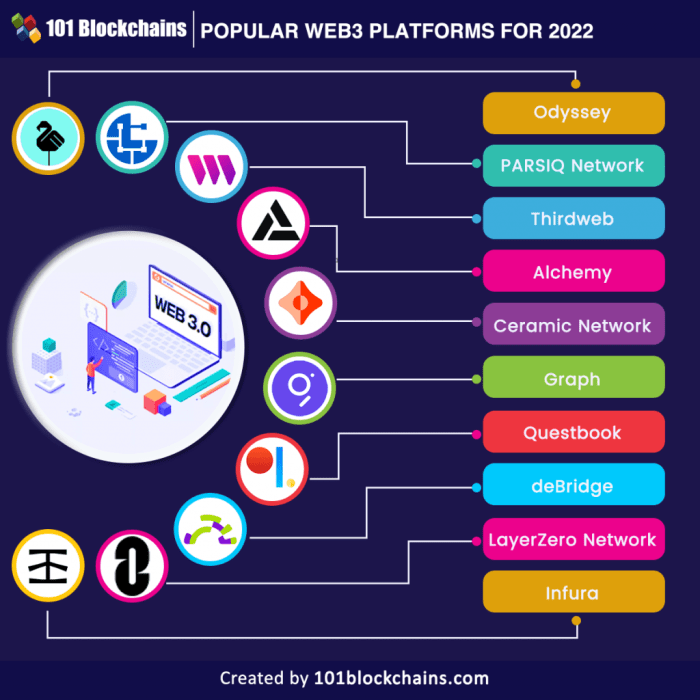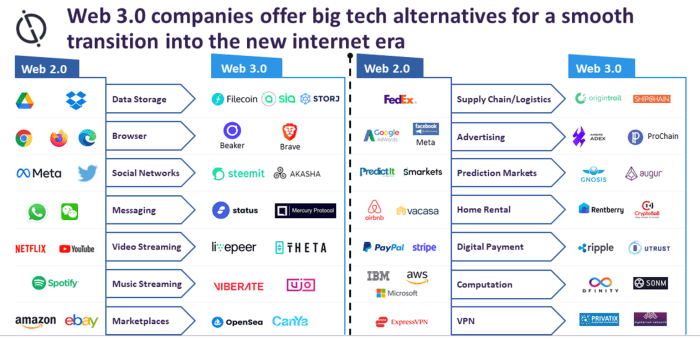Web3 applications are all the rage right now, bringing a new wave of innovation and decentralization to the digital realm. Get ready to dive into a world where blockchain, NFTs, and finance collide in the most epic way possible.
From redefining traditional web applications to exploring real-world use cases, Web3 applications are here to shake things up and revolutionize the way we interact with technology.
Introduction to Web3 Applications
Web3 applications are the next generation of decentralized applications that leverage blockchain technology to provide users with increased security, privacy, and control over their data. Unlike traditional web applications that rely on centralized servers, Web3 applications are built on blockchain networks, offering a peer-to-peer and trustless environment.
Significance of Web3 Applications
Web3 applications are significant in the digital landscape as they enable users to interact directly with each other without the need for intermediaries. This ensures greater transparency, reduces the risk of data breaches, and enhances user autonomy. Additionally, Web3 applications have the potential to revolutionize various industries by offering new business models and opportunities for innovation.
Differences from Traditional Web Applications
– Web3 applications operate on decentralized networks, while traditional web applications rely on centralized servers.
– Web3 applications use smart contracts to automate processes and ensure trust, whereas traditional web applications require intermediaries to facilitate transactions.
– Web3 applications prioritize user privacy and data ownership, while traditional web applications may collect and monetize user data without their consent.
Technologies Powering Web3 Applications
- Ethereum: A popular blockchain platform that supports the development of smart contracts and decentralized applications.
- IPFS (InterPlanetary File System): A decentralized storage protocol used to store and retrieve data in Web3 applications.
- Web3.js: A JavaScript library that allows developers to interact with the Ethereum blockchain and build decentralized applications.
Key Features of Web3 Applications

Web3 applications have several unique features that set them apart from traditional web applications. These features include decentralized architecture, immutability, and transparency, among others.
Decentralization
Decentralization is a key feature of Web3 applications, achieved through the use of blockchain technology. In Web3 applications, data is not stored on centralized servers controlled by a single entity. Instead, data is distributed across a network of nodes, making it resistant to censorship and single points of failure.
Immutability
One of the defining characteristics of Web3 applications is immutability. Once data is recorded on the blockchain, it cannot be altered or deleted. This ensures data integrity and trust in the system, as all transactions are transparent and verifiable by anyone on the network.
Transparency
Web3 applications promote transparency by making all transactions and data publicly accessible on the blockchain. This transparency builds trust among users and eliminates the need for intermediaries to validate transactions, reducing costs and increasing efficiency.
Smart Contracts
Smart contracts are self-executing contracts with the terms of the agreement directly written into code. They automate processes and remove the need for intermediaries, ensuring trustless interactions between parties. Smart contracts play a crucial role in Web3 applications, enabling secure and efficient transactions.
Tokenization
Tokenization is another key feature of Web3 applications, where assets are represented as digital tokens on the blockchain. This allows for fractional ownership, increased liquidity, and new forms of value creation. Tokens can represent anything from digital art to real estate, revolutionizing the way assets are bought, sold, and traded.
Use Cases of Web3 Applications
Web3 applications are being adopted across various industries, revolutionizing the way we interact and transact online. Let’s delve into some real-world examples of Web3 applications and their impact.
Finance
Web3 applications are transforming the finance industry by enabling decentralized finance (DeFi) platforms. These platforms allow users to access financial services such as lending, borrowing, and trading without the need for traditional intermediaries like banks. Smart contracts powered by blockchain technology ensure secure and transparent transactions.
Gaming
In the gaming industry, Web3 applications are creating opportunities for players to truly own in-game assets through the use of non-fungible tokens (NFTs). NFTs allow gamers to buy, sell, and trade unique digital items, providing a new level of ownership and value to virtual assets. Blockchain technology ensures the authenticity and scarcity of these items.
NFTs
Non-fungible tokens (NFTs) have gained popularity beyond gaming, finding applications in art, collectibles, music, and more. Web3 applications are enabling creators to tokenize their work and sell it directly to collectors, eliminating the need for intermediaries. This has opened up new revenue streams for artists and creators while providing collectors with verifiable ownership of unique digital assets.
Other Sectors
Web3 applications are also making waves in sectors such as supply chain management, healthcare, and real estate. By leveraging blockchain technology, these industries can improve transparency, traceability, and security in their operations. Smart contracts automate processes and reduce the risk of fraud, benefiting both businesses and consumers alike.
Challenges and Opportunities in Web3 Applications

Web3 applications present a new frontier in the digital landscape, bringing along a set of challenges and opportunities for developers and users alike. The decentralized nature of Web3 technology introduces unique hurdles that need to be addressed, but also opens doors to innovative solutions and growth potential.
Challenges Faced in the Web3 Ecosystem
In the Web3 ecosystem, developers encounter challenges related to scalability, interoperability, and security. The decentralized nature of Web3 applications can lead to scalability issues, as transactions need to be processed across multiple nodes in the network. This can result in slower transaction speeds and increased costs. Additionally, ensuring interoperability between different blockchains and protocols can be complex and requires standardization efforts. Security is another major concern, as the distributed nature of Web3 applications makes them susceptible to various attacks and vulnerabilities.
Scalability Issues and Potential Solutions, Web3 applications
To address scalability issues in Web3 applications, developers are exploring solutions such as sharding, layer 2 solutions, and sidechains. Sharding involves splitting the blockchain network into smaller parts, allowing for parallel transaction processing and improving scalability. Layer 2 solutions, such as state channels and sidechains, enable off-chain transactions to reduce the load on the main blockchain network. These approaches aim to enhance transaction throughput and reduce fees in Web3 applications.
Opportunities for Innovation and Growth in the Web3 Space
Despite the challenges, the Web3 ecosystem offers significant opportunities for innovation and growth. Decentralized finance (DeFi), non-fungible tokens (NFTs), and decentralized autonomous organizations (DAOs) are just a few examples of the innovative applications that have emerged in the Web3 space. These technologies have the potential to revolutionize various industries, including finance, art, and governance. As the Web3 ecosystem continues to evolve, there is immense potential for developers to create novel solutions that leverage the benefits of decentralization and blockchain technology.
